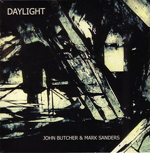|
|
 |
Dusted Reviews
Artist: John Butcher and Mark Sanders Album: Daylight Label: Emanem Review date: Oct. 2, 2012 |

|
|
|
 |
When thinking about John Butcher’s playing, it tends to be in contexts without drummers. His early recordings were in solo context, his work with pianist Chris Burn in duo and ensemble, and the phenomenal trio with John Russell and Phil Durrant . (Paul Lovens guested with the trio on News from the Shed, but that was a one-off.) Since those early endeavors, Butcher has forged a singular approach to saxophone playing that has found particular resonance in drummer-less contexts, such as improvisers using electronics like Toshi Nakamura and Christof Kurzmann or in non-standard instrumentation like his trio with Axel Dörner and Xavier Charles or his duo with Rhodri Davies.
But he’s had ongoing working relationships with drummers since joining up with John Stevens in the early 1990s in what was to become the last iteration of Spontaneous Music Ensemble. In the ’90s, Butcher met up with Gino Robair when he was playing in the Bay Area (a relationship that has remained ongoing), connected with Gerry Hemingway, and began working with Dylan van der Schyff in both duo settings, as well as a trio with bassist Torsten Müller. In Europe, he also began playing with Steve Noble and Eddie Prévost, and more recently, Mark Sanders. Butcher and drummer Sanders met each other in the mid ’80s, but somehow never got to playing together until recently. The matchup is a natural, as documented on these recordings from the 2010 Freedom of the City Festival and a 2011 gig in Southampton.
I was in attendance for the Freedom of the City set and the recording brings back memories of that afternoon. London’s Conway Hall has a large central skylight and the weather was particularly changeable that day, with the sun peaking in and out as dusk was settling in. That constantly morphing light was the perfect backdrop for the way that Butcher and Sanders shaped their 30-minute set, playing with the attack and resonances of their sound in the room. Butcher’s burred tenor multiphonics and percussive flutters and pops hang against Sanders’ cymbal sizzles, clattering bells and gongs, and lithe tumbles and rolls. The two build momentum slowly, mounting flows of tension and then gauging density back to build renewed waves. Switching to soprano, Butcher introduces micro-detailed overtones and breathy streams against Sanders’s pointillistic playing, crescendoing into shimmering flumes. For the final section, Sanders gradually mounts patterns of chafing densities and Butcher responds with fricative jabs and cries, finishing things off with an explosive burst of potent intensity.
The two pieces from Southampton are more compact, and provide a different view of Butcher and Sanders duo approach. The first, “Flicker,” mines the interplay of abstracted textural details, an area both have worked in extensively. Over the course of six minutes, it is as if the two are feeling out the sonic possibilities of the room. The 19-minute “Glowstick” takes off from there, starting with a galvanizing force and then pulling back as Butcher’s multiphonics quaver against Sanders’ bowed ghost tones. The piece moves back and forth between the composure of pools of timbral exploration and vigorous arcs of circularly breathed cascades and crackling percussive salvos. While there are clear nods to the intensity of free-jazz reeds/drums showdowns, the two place this within an overarching context of a more formal approach. Taken together, these two performances provide a bracing view of this duo and the possibilities yet to explore in the reeds/drums context.
By Michael Rosenstein
|







